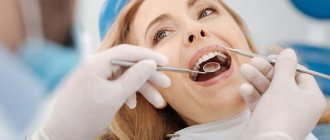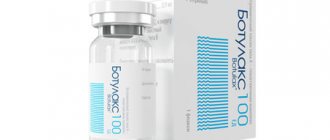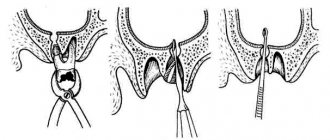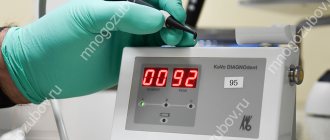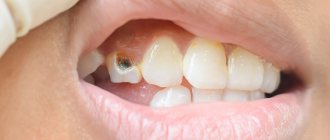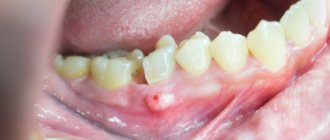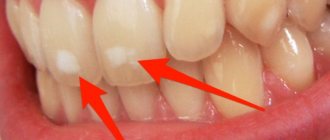Why does my cheekbone hurt?
Traumatic injuries
The most common injury to the zygomatic region is bruise.
Occurs in fights, less often when falling or hitting a hard surface (for example, a door frame). The pain is moderate and subsides quickly. Local swelling and hyperemia are observed, abrasions are possible. Opening the mouth is not difficult, speech is not changed. All symptoms disappear within a few days or 1-2 weeks. When the zygomatic bone is fractured, the pain is very sharp and intense. Bruising is detected, swelling quickly spreads to the adjacent parts of the face. There is pain when trying to open the mouth, numbness of part of the cheek, wing of the nose and upper lip, and sometimes diplopia. If the integrity of the maxillary sinus is violated, nosebleeds develop and subcutaneous emphysema is possible. When fragments are displaced, a step is felt in the cheekbone area.
The zygomatic bone participates in the formation of the orbital wall. If the bone wall of the orbit is damaged, along with the symptoms listed above, limited mobility of the eyeball, visual impairment, subcutaneous emphysema, exophthalmos or endophthalmos are detected. Orbital injuries can also be accompanied by double vision, strabismus, and in severe cases, blindness.
Osteomyelitis
Severe tugging, throbbing pain in the cheekbone may be a consequence of post-traumatic osteomyelitis. The disease develops after an open fracture, surgery on the zygomatic bone and nearby tissues. The wound becomes swollen, its edges turn red. Suppuration, intoxication, and general hyperthermia are observed. After opening the abscess, pain and inflammation subside, and a fistula tract forms in the wound area.
Neuralgia
Burning, shooting pain in the cheekbone, reminiscent of an electrical discharge, is characteristic of damage to the second branch of the trigeminal nerve. Pain sensations spread from the side of the face to the center, affecting the upper part of the cheek, upper jaw, upper lip, and nasal mucosa. Attacks of neuralgia last up to 2 minutes and are repeated several times, causing patients to freeze in place.
In patients with ganglionitis of the pterygopalatine ganglion, intense prosopalgia predominates in the area of the cheekbone, eye, hard palate and base of the nose, but the symptom is never clearly localized, since a large number of nerve branches causes the spread of pain to adjacent parts of the face, gums, teeth, and sometimes the back of the head, neck , temple and ear. A distinctive feature of the pathology is pronounced autonomic symptoms: lacrimation, hypersalivation, hyperemia and swelling of half the face.
Sometimes the cause of radiating pain in the cheekbone is ganglionitis of the geniculate ganglion, although for this variant of ganglioneuritis pain in the ear with irradiation to the back of the head, face and neck is more typical. Painful sensations are paroxysmal in nature, and in some patients they are combined with neuritis of the facial nerve.
Cheekbone pain
Muscle damage
In patients with bruxism, bilateral aching pain in the cheekbones is caused by overstrain of the masticatory muscles during repeated nightly episodes of teeth grinding. Drowsiness, headache, toothache, and soreness in the jaw area are possible. Chips, cracks, hyperesthesia and pathological abrasion of teeth are often observed. With myofascial syndrome, pain increases gradually and is a consequence of constant muscle tension when clenching the jaw against the background of overload, stressful situations, and neurotic disorders.
Dental pathologies
Irradiation into the cheekbone is observed when the upper premolars and molars are affected on the corresponding side. In some cases, the pain in the cheekbone is so pronounced that it prevails over the pain in the teeth. The symptom can be observed after tooth extraction, with alveolitis, pulpitis, periodontitis. With deep caries, it does not occur spontaneously and is associated with food entering the carious cavity.
Otolaryngological diseases
The maxillary sinus is located in the body of the maxillary bone. Its wall borders the zygomatic bone, which causes pain to spread to the cheekbone when this sinus is affected. The symptom appears in the following diseases:
- Acute sinusitis.
There are bursting pains in the projection of the sinus, cheekbone, root of the nose and forehead, which intensify when palpated. Intoxication syndrome, fever, and nasal congestion are detected. - Aerosinusitis.
A similar localization of pain is observed with aerosinusitis (if the maxillary sinus is affected), but hyperthermia and intoxication occur only with secondary infection. - Acute pansinusitis.
A clear clinical picture is characteristic. Chills, febrile temperature, and severe intoxication occur. The general condition is serious. Pain from the cheek and cheekbone spreads to the eyebrows, orbits, crown and back of the head, sometimes extends to the lower jaw, is combined with a constant diffuse headache, and with a prolonged course is supplemented by progressive neurological disorders (insomnia, weakness, paresthesia).
In addition, acute bursting pain in the cheekbone is typical of one of the orbital complications of sinusitis - orbital osteoperiostitis. The spread of the inflammatory process to the lower outer wall of the orbit causes the involvement of the zygomatic bone. Along with the symptoms of sinusitis, significant swelling of the periorbital tissue, exophthalmos, displacement and limitation of eye mobility are detected.
Other reasons
Headaches with possible irradiation to the cheekbone are observed in diseases with a completely unclear etiology - cluster headaches and paroxysmal hemicrania. Sometimes the epicenter of pain in the cheekbone with spread to other areas is noted with atypical facial pain. Pain syndrome of psychogenic origin against the background of stress or overwork is formed in emotionally unstable, suspicious people. In some cases, the symptom is found in patients with hypochondria and occurs in delusional and hallucinatory disorders.
Useful video
This video shows what to do if you have a headache in the forehead and temples:
Obviously, a headache that radiates to the eyes is a very common symptom , which is why most people are familiar with it firsthand.
Despite its commonness, it is unacceptable to neglect the condition . Perhaps the cause of the malaise is harmless, but it may also indicate serious disorders.
If there are no reasons for the pain in the form of stress and lack of sleep , and it does not go away on its own, you should immediately consult a specialist , forgetting about self-diagnosis and self-medication.
Diagnostics
The cause of pain in the cheekbone is determined by the maxillofacial surgeon. According to indications, the patient is referred to an otolaryngologist, neurologist, and other specialists. During the survey, the time and circumstances of the onset of the symptom, the dynamics of its development, and the presence of other manifestations indicating the nature and localization of the pathological process are established. During the dental examination, dental diseases are excluded.
When determining the etiology of neuropathic pain, an important role is played by the study of trigger points and special tests (for example, with dicaine and adrenaline for ganglionitis of the pterygopalatine ganglion). To clarify the diagnosis, the following procedures are prescribed:
- Radiography.
X-ray examination of the zygomatic bone, orbit or maxillary sinus is used for injuries, osteomyelitis, sinusitis, and pansinusitis. Allows you to establish the type and severity of the pathology, determine the need to prescribe additional techniques or treatment tactics. - Other imaging techniques
. They are used at the final stage of the examination when X-ray data are ambiguous. Provide detailed information about the location, characteristics and extent of the pathological focus. - Otolaryngological examination
. Indicated for ENT diseases. May include anterior rhinoscopy, diagnostic puncture and probing of the maxillary sinus. - Lab tests
. Inflammation is characterized by leukocytosis with a shift to the left and an increase in ESR. In purulent processes, based on the results of inoculating the material on nutrient media, the pathogen is determined and antibiotic sensitivity is established.
Dental treatment
Causes of muscle spasms
Why is this happening? In fact, there can be many reasons. Most often, constant nervous strain, hypothermia or vitamin deficiency play a role. Only high-quality diagnostics can identify the specific cause. Often this trouble is caused by concomitant diseases of the musculoskeletal system, for example, osteochondrosis, which develops for the following reasons:
- Genetic predisposition.
- The presence of obesity of various degrees.
- Low activity.
- Poor metabolism.
- Sedentary work.
As mentioned above, muscle spasms in the head and neck are dangerous to health. First of all, the danger is manifested by the fact that regular spasms negatively affect blood circulation, that is, the required amount of oxygen does not reach the brain. This can lead to serious consequences, such as hypoxia. It is for this reason that experts do not recommend self-medication.
If you constantly ignore the manifestations of osteochondrosis, this is fraught with the development of additional pathological processes. Often people completely lose their ability to work; in more advanced cases, this can lead to disability. Before starting treatment, the patient is required to undergo a series of diagnostic procedures. If you begin to restore your health in time and take measures to eliminate spasms, you can return to your normal lifestyle.
Treatment
Conservative therapy
Analgesics are used to eliminate intense pain. The list of other therapeutic measures is determined depending on the characteristics of the pathological process:
- Traumatic injuries
. Patients with a fresh fracture of the zygomatic bone without displacement are prescribed a protective regimen, gentle nutrition, and physical therapy. If there is displacement, reposition is performed, then management is carried out in the same way as in the previous case. - Osteomyelitis
. The basis of treatment is antibiotic therapy, taking into account the sensitivity of the pathogen. Antibiotics are administered intramuscularly, or intraosseously during surgery. They or nitrofurans are used to wash the surgical wound. - Neuralgia
. Patients with damage to the trigeminal nerve are prescribed anticonvulsants; antispasmodics, antihistamines, and medications to improve microcirculation are used as auxiliary agents. For ganglionitis, the nasal cavity is lubricated with dicaine, and ganglion blockers are sometimes used. Along with general remedies for neuropathic pain, therapeutic blockades are effective. - Dental diseases
. Taking into account the nature of the pathology, the tooth socket is washed or the tooth cavity is treated, followed by the application of anti-inflammatory and regenerating pastes. The list of general agents includes sulfonamides and antibiotics. - Inflammation of the paranasal sinuses
. Patients are recommended antibacterial, anti-inflammatory, detoxifying and antihistamine drugs, immunocorrectors. Punctures are performed and a YAMIK catheter is installed.
Diagnosis and treatment of headaches and neck pain
If you have such a diagnosis, and you are forced to regularly experience headaches and other unpleasant symptoms, immediately visit a medical doctor.
institution. Treatment of the musculoskeletal system is carried out in the modern TitAn clinic. The medical center has innovative equipment that will help determine the cause of spasms. Specialists with many years of experience will prescribe you effective treatment, and you will forget about your problem forever.
The first stage is a qualitative diagnosis, which includes the following:
- Palpation diagnostics (author’s method of the head physician of this medical center).
- Computed tomography, magnetic resonance imaging.
- Clinical studies that will help to correctly diagnose and develop further treatment tactics.
The above diagnostic methods in combination lead to excellent results and the manifestation of a complete clinical picture. It is possible not only to determine the cause of spasms, but also to characterize in detail the pathological process and its features. With the help of correctly prescribed treatment, the results of therapy will make themselves felt in the near future.
The main goal in the treatment of pathologies of the musculoskeletal system is to normalize blood circulation in the vessels, which is the cause of many degenerative processes. The medical clinic accepts patients with any pathologies of the spine, including those with neck and head spasms. Doctors treat even the most advanced stages of the disease. Even if other clinics have refused you therapy, feel free to contact us! Highly qualified specialists will quickly find out the cause of your discomfort and prescribe effective treatment!

